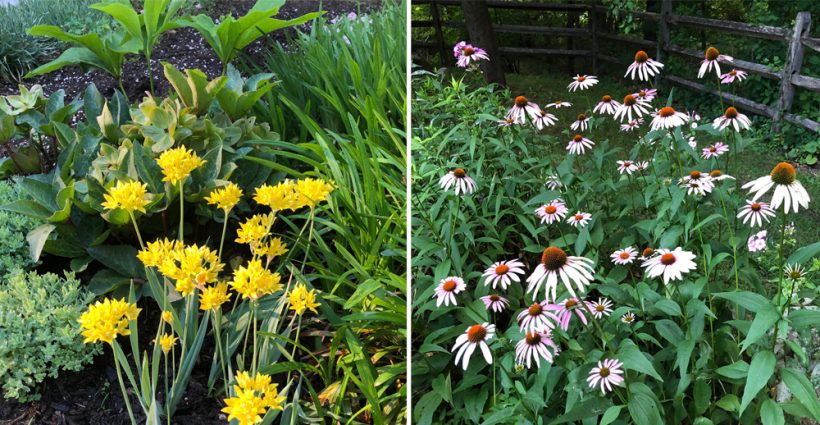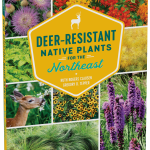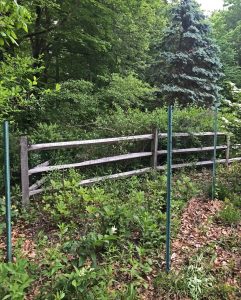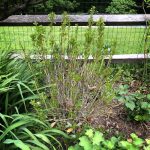designed for the way women work.

Deer-Resistant Native Plants for the Northeast by Ruth Rogers Clausen and Gregory D. Tepper
Category: Presenting "The Curious Gardener"
Horticulturist and author Ruth Rogers Clausen has a new book out, published by Timber Press, titled “Deer-Resistant Native Plants for the Northeast,” co-authored with Gregory D. Tepper. Womanswork is giving away a copy of her new book, which features 75 native plants that deer seldom browse. She gives each plant a deer resistant rating from 7-10. Anything below 7 is considered deer candy and is not included in the book.
To enter, tell us in a Comment below, or via Facebook or Instagram, why you want to win this book. Entries must be submitted by Sunday June 6th.
Here are some highlights Ruth picked out from her book for “Curious Gardener” readers.
- If you co-exist in an area with deer, sooner or later they will probably find your garden and want to use it as a buffet.
- Deer are creatures of habit and return to the same place over and over again for food and to drop their young. If a fawn is born on your property be assured that it will return its whole life to that spot. If you see a pregnant doe, move it along gently beyond your property.
- If food is scarce and deer are stressed by hunger there is no plant that is reliably deer PROOF. Some plants are commonly known as “deer candy”—phlox, daylilies, tulips, hostas, crab apples, trilliums, poison ivy etc.
- Others are considered “deer resistant” of various reliabilities – sages, yarrows, ferns, ornamental grasses and sedges, bush cinquefoil, baptisia etc. The scale of deer browsing ranges from them sometimes nipping off the flowers but ignoring the foliage, as in astilbe, to almost never feeding on the plants at all, as in hellebores.
- However different herds have different palates, and these vary considerably from garden to garden, to different areas, and from year to year. 2020 was a year when the oak trees in particular produced huge crops of acorns, one of the favorite foods for deer.
- In general plants with certain features are less likely to be browsed by deer: fuzzy leaves, tough leathery or fibrous foliage, aromatic flowers and/or leaves, spines or bristles, poisonous compounds.
- Plants grown soft with plenty of fertilizer and water are prime targets for deer.
- Watering from above, especially late in the day, encourages deer to stop by for a meal that night. If it is hot and dry, deer will be thirsty as are we.
- Protect newly planted young trees and shrubs from buck rubbing and browsing until the plants are well established.

Here are some additional lessons I’ve learned as a gardener in deer territory:

In winter food is always scarce so the best protection for evergreen shrubs is to wrap them in burlap or fence in sections of your garden that you want to protect. In the spring after new growth begins and food is more plentiful, you can unwrap those plants. I planted a grouping of 3 oakleaf hydrangeas two years ago and they were eaten pretty well by the deer their first winter, so last fall we put a temporary fence around them and they have nicely leafed out this spring. I think I’m going to leave the fence up for a while longer to be safe. I’ve been told that most shrubs can survive one season of being chomped on by deer, but two seasons can permanently weaken them.
Early in the spring as perennials begin to emerge, try to get the deer who visit your garden out of the habit of grazing by spraying the plants with a deer repellant. Continue to spray every week or so to protect new growth. Deer will often lose interest and no longer view this as a prime feeding area. Deer sometimes get accustomed to a particular deer repellant and it is no longer as effective. So have a few different brands, with different odors and tastes, on hand. Of course deer repellants can’t be used on edibles.
This treatment is necessary for newly planted perennials too. Nurseries will pump their plants with fertilizer to make them look more appealing at point of sale. This sends out a lot of tender new shoots which is more appealing to the deer also.
Dogs can be a deterrent. Send them out to the garden and their scent will deter deer. Sometimes I encourage my dog Daisy to wander among the plants just to get her scent out there.
Recently there was an article by Margaret Roach in the New York Times titled “The Elusive Deer-Proof Garden”. The article focuses more on strategies for deterring deer, than on plants to grow as in Ruth’s book. If you’re a subscriber to the NY Times you can pick up some really good information. Read it here.



Would love to know about native plants that i can garden with and not simply feed them directly to the deer. In the winter they have been hungry enough to browse my Mountain Laurel that grows right by the house…
My best friend moved from So Calif several years ago to live on 2 acres in Salem, Oregon. She discovered that whatever she planted was mysteriously disappearing. Being a native suburban girl, she was dumbfounded. She will love this book in order to live harmoniously with the deer and other critters that “share” her property.
Moving to the mountains next year; need to learn all about “deer.”
The deer actually nibbled on my hellebores this year! I’d like to add some plants to the gardens other than ferns, rhodies and azaleas. This book would be a great help, please.
Help, I have a deer and rabbit problem.
We daily see 12-18 deer wandering through our yard and they are not shy about eating our shrubs and plantings.
Having other choices would be helpful.
Ruth and Gregory’s book sounds like a must-read for my community in NE Ohio. Personally, my battle with the deer is on-going as I vary my repellants, change my plantings and even use low-tech scare tactics. Still, my hostas disappear. This book may have just the right answer for me!
I grew up in rural PA where it was accepted to cull the herd with strict hunting seasons. They would often raid our family garden, but mostly were able to find food. For 25 years I have lived and gardened in rural Long Island. I became hooked on transforming my acre property into a wildlife sanctuary, but the deer have recently become so frequent that the tick population is unhealthy and gardening quite challenging. I refuse to believe we can’t try to co exist. I have over 30 wild turkey that frequent my property and manage to avoid by Belgian sheepdog. I am super excited to read your book and would love to win one!!! Already putting in my order for more Alliums moly Jeanine. I need MORE inspiration.
I would like to win this book for two reasons: to help me with my own perennial flower gardens, and to give to the leader of the “Invasive Species Strike Team” of our city parks.
First, my flower gardens. We live in a housing development on the edge of Indianapolis, 0.1 miles from a large reservoir and 0.4 miles from a park that consists of about 500-acres of woods (with a huge wild deer population), plus another 400 or so acres of reservoir. I’ve often seen deer on our property, and once even found one sleeping on our back yard deck. I’ve seen them at night (up to a herd of six at one time), in the evenings, and even occasionally in the daytime. Even before I became a Mistress (a.k.a. Master for men) Gardener, I learned to use PlantSkydd and to plant daffodils, echinacea, rudbeckia, and lily-of-the-valley, but. I need a LOT more ideas on how to defend my flower beds without unsightly fences all over the front yard beds.
Second, the Invasive Species Strike Force: This is a group of retired, mostly Master/Mistress Gardeners that convenes monthly under the direction of the city parks’ environmentalist (Brenda H.) who direct us in removal of invasive plants and planting of native species in our city parks. Brenda is amazingly knowledgeable, but she and some of her staff could use this book for more ideas. If she likes the book, she’ll mention it or show it to our Strike Team group. That likely would stimulate more book sales for the authors. I’ve learned a lot from Brenda and would like to give back by gifting this book to her and the Environmental Management division of our city parks.
The deer passing through my garden eat everything like it’s their last supper. I tried so many “remedies” over the years but none of them seem to work. They keep coming, they keep munching and they keep bringing their friends lol. Ready to grow something they don’t like.
We now have herds of deer in our neighborhood and up until 2 years ago they never jumped my split rail fence but now they do it all the time even when people are around. All the nice plants I thought were safe in the backyard are now deer snacks!! Ugh! I know they have just as much right to be here as we do and want to respect that so this book would be great to have to help me replace what has been eaten and stay native.
This looks like it would be a great reference for deer resistant plants! Also full of useful tips to thwart those pesky (but cute when they are little) creatures!
Living in Oregon for the past 7 years we joyfully have an abundance of wildlife, along with the beautiful and always hungry deer. We’ve learned the hard way that they enjoy eating roses~! Our property is a paradise now showing the efforts of 7 years of planting all kinds
of flowers/shrubs, unveiling the overgrown garden and nurturing the older fruit and nut trees back to producing edibles. The next project is a greenhouse for year ’round treats~! We love and protect our deer, raccoons, bobcats, rabbits, ducks, geese, bats and take in any stray cats that seems to be perpetually dumped off at our road’s edge (we’re near the top of a remote road) – thus we installed automatic feeders, perches and heated beds for the kitties (they are neutered/spayed/microchipped as well once they come to us), molasses oat licks for the deer, bird, bat and duck houses for safe nesting places and the old shed has a temperature controlled heat lamp for the creatures to get warmed up by. The deer and raccoons peer at us from outside at times, many sleep in our various garden areas under that tall fir trees, then know they are safe. So for us we would treasure having more knowledge about how to keep the place in total beauty, yet to not be consumed by the deer. With “No Hunting” signs posted at all sides of our property, the deer have a haven of respite. No chemicals used on our place either, now or ever on our 8 acres of paradise, but the deer do nibble away – so any education you can offer is much appreciated~!
I doubt if our deer can read but I’d love to voice over a copy of this book while they just look at me and indicate, “Pocession is 9/10th of the law”.
The deer where we live in upstate New York eat everything I plant. This year I decided not to buy any new plants because I don’t want to give the deer any more things to eat. Would love the win the book so I can begin planting again.
Thank you.
You need to write a book about Deer Resistant Plants in the Southeast too, please. We have problems with deer also. Although I know your new book will be helpful since many of the plants you recommend also grow in the S.E.
This book looks like it will be very interesting
I would love to win this book, it sounds essential for gardeners who have to coexist with deer.
I am confident that this book would be extremely useful in the ongoing operation of our mountaintop deer smorgasbord; we have named it “McDoenalds.” The patrons pay little attention to the meander-thru lane guidelines and eat as they please (and never pay). We no longer serve ‘hoppy meals’ to the fawns as they just bug their parents to return (every day at the same time). The entire population sees our flower garden and black raspberries patches as all you can eat. This book would help keep us (from) repeat trips to surrounding nurseries that ask us if we want ‘the usual’ when we arrive,!
Our garden on Martha’s Vineyard is close to a fresh water pond which both attracts deer to the water and limits our ability to use some deer repellent products. We would love to know more about using native plants in our area so both our abundant deer and our plants can be safe
I love the deer but not some of their habits. Let’s create a garden that a deer admires for color and variety but not taste. Let’s reduce the odds for Lyme. Your book will contribute so much to our enjoyment and health!
I’d love to win this book because I just retired and plan to overhaul my flower borders. I’ve lost many plants to deer over the years. This will help me break in the woman’s work gloves I purchased this spring. Thanks ?
I can not find an area to enter the giveaway for the deer resistant plants.
I hope you can use this as my entry.
I’ve experienced deer eating my so-called deer resistant plants. Possibly due to an extra cold winter?
However, I’d like to educate myself as much as possible in the topic.
Thank you
I live in a wonderful place – and the deer love it as well. We live on a hill, about 350 feet above the pacific ocean. The view is fabulous and the deer frequent the neighborhood as well. No one has fences in their yards – I do have my veggies behind a fenced in area but my front yard is nothing but periennials. We also have a patio – enclosed by the house and a large hedge. We came home at one point to find the deer had entered through the hedge, jumped down about 6 feet and were eating the apples on our columinar apple trees! Now we have a fence beside the hedge as well.
I keep taking this book out of the library and running up overdue fines. It’s time I had a copy of my own! I’d love to be your winner for this beautifully photographed and terrific reference book.
Ruth and Gregg are such a dynamic duo! With Gregg’s love of nature and practical experience managing large public spaces and Ruth’s loving (ha!) opinions on plants and the critters that sample them, you can’t go wrong. What a gift to have them collaborating!
I live in a CCC community a mile from the center of town but bordering a cemetery, woods, canal and river. Here in PA we have more deer than centuries ago. Thankfully the community built a raised bed garden with a very high fence for vegetable gardening. Around our homes is another story. Deer are a constant. I love the concept of this book and would love to have a copy to share with the community.
I live in Northern Virginia. I have had to give up on bird feeders because they attract the local black bears. I am now trying to plan bird friendly plants that can survive the local deer. This book would be very helpful.
Camille, you are entered!
My sister’s birthday is June 6th and I would love to give her this book. Her property borders on woods here in northwest NJ and the deer have given her house a 5 star Michelin rating. They eat everything she plants, whether it’s supposedly deer resistant or not. Except the astilbe’s….which don’t grow so well anyway. She desperately needs some help! Your book would be perfect,
I have been unwillingly feeding deer during the 30+ years we have lived in Southeastern Pennsylvania. The back of our property slopes down to a gully that connects with a nearby arboretum which houses a small deer herd. One year, Bambi showed up and liked it so much she gave restaurant recommendations to all her friends.
My approach to deer-resistant plants has been Darwinian: if it lasts less than 24 to 72 hours, it won’t get replaced. So I’ve learned something about deer candy vs toxic/textured/fragrant plants. But I’m sure there’s much I am missing and would surely appreciate new ideas from Clausen’s & Tepper’s book.
We live in an early (1736) house with additions . Our house is in the middle of 10 acres, six of which are still forest and streams. We delight in seeing “our” Deer all year long. We are especially happy when we can see the newborn fawn in the spring. We do put out deer-blocks in several areas for them. We hope the extra food in the fall and winter keep them here with us and not going to other areas where the hunters are. So it must be clear how much we treasure them, take pictures of them and even plant green plantings that we know they will enjoy. Our hope is to make sure they have enough of that plant food so that they will avoid the plants that we also love but know that they love them too!!
This book will keep us informed of the plantings we want to do for our deer and also the ones that we hope can just be for us.
I love to garden, but have been so discouraged this year in particular because it seems like anything I plant, even deer resistant plants or plants that deer never bothered in past years, have become snacks for Bambi. I would love a copy of your book to win the deer wars — or at least save some of my garden!
I live on 14 acres of woods, fields, and cultivated gardens in western Massachusetts, and have had a battle with deer for decades. As I plan additions to the landscape I’d love to know which trees/shrubs/plants are deer resistant. thank you
A dear friend is moving from this suburban neighborhood to 13 acres in the woods. I’d love to offer her all this information!
Thank you so much for having this giveaway! I have a love-hate relationship with deer. I often come upon a whole patch of my garden grazed, sometimes mowed down by one of the 6+ deer herds in the area. I love that Ruth Rogers Clausen’s book focuses on natives. That way, I can focus on feeding key pollinators and birds while keeping the deer somewhat away!
Many yards and gardens have lopsided bushes and shrubs, from deer browse. Despite this, I remain a deer fan! They are such beautiful animals, if we can garden in a way that attracts them less, I’m all for that as a solution. We’re the folks who moved into their world.
Last year, my first year in my current house, I focused on deer-resistant plants. This year I would like to add the native component to deer resistance. Trial and error has shown the deer do not read or heed what they are said to be resistant to. I don’t want to fight them; I want to coexist respectfully with them.